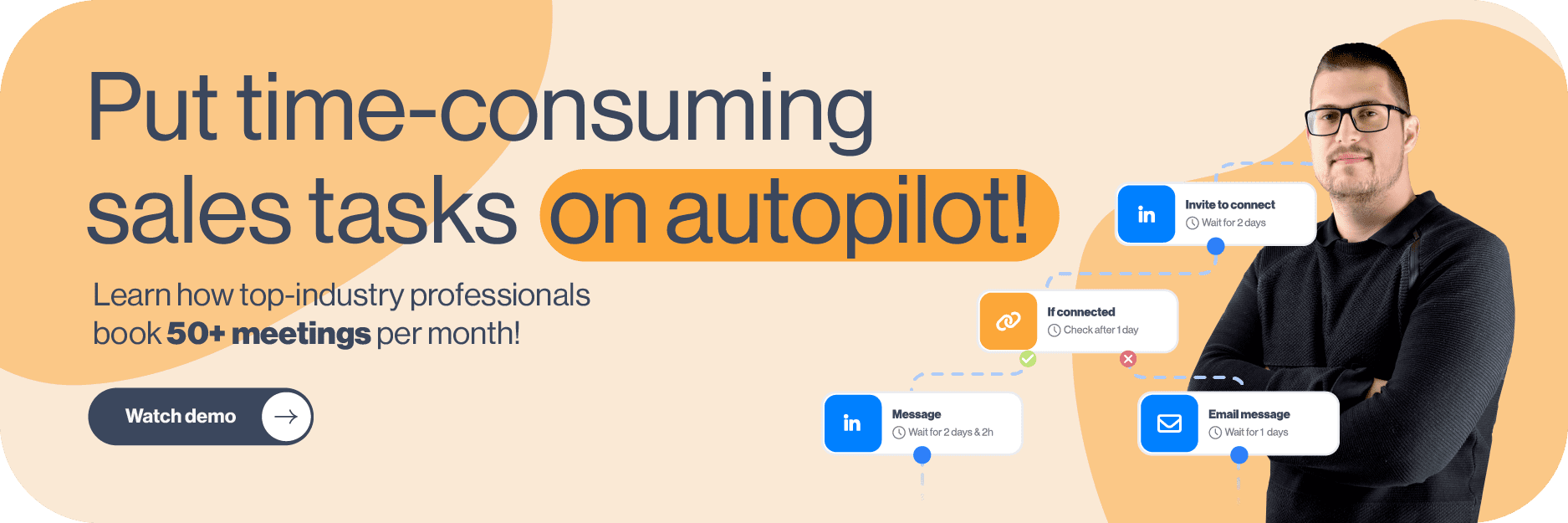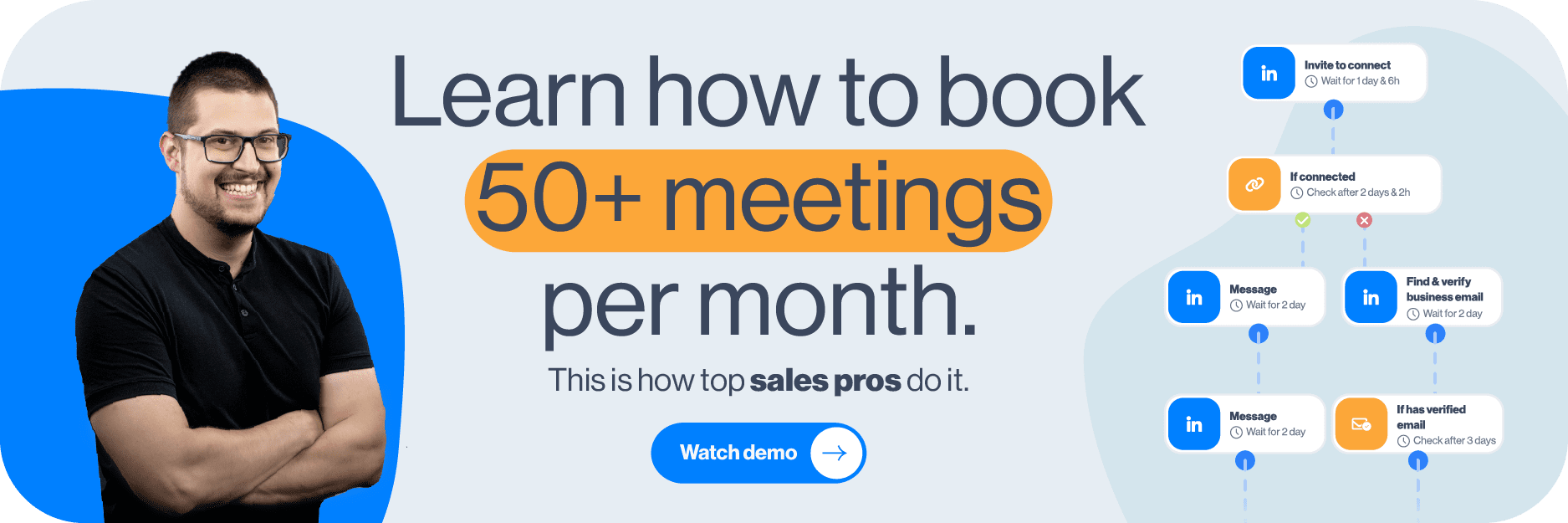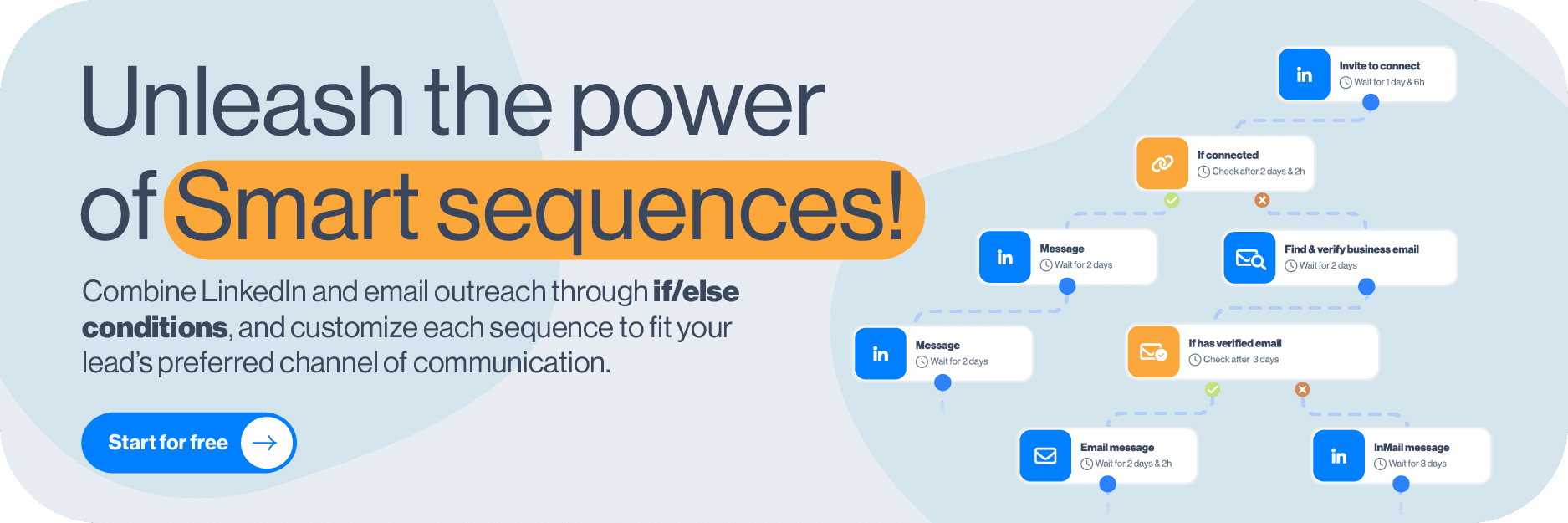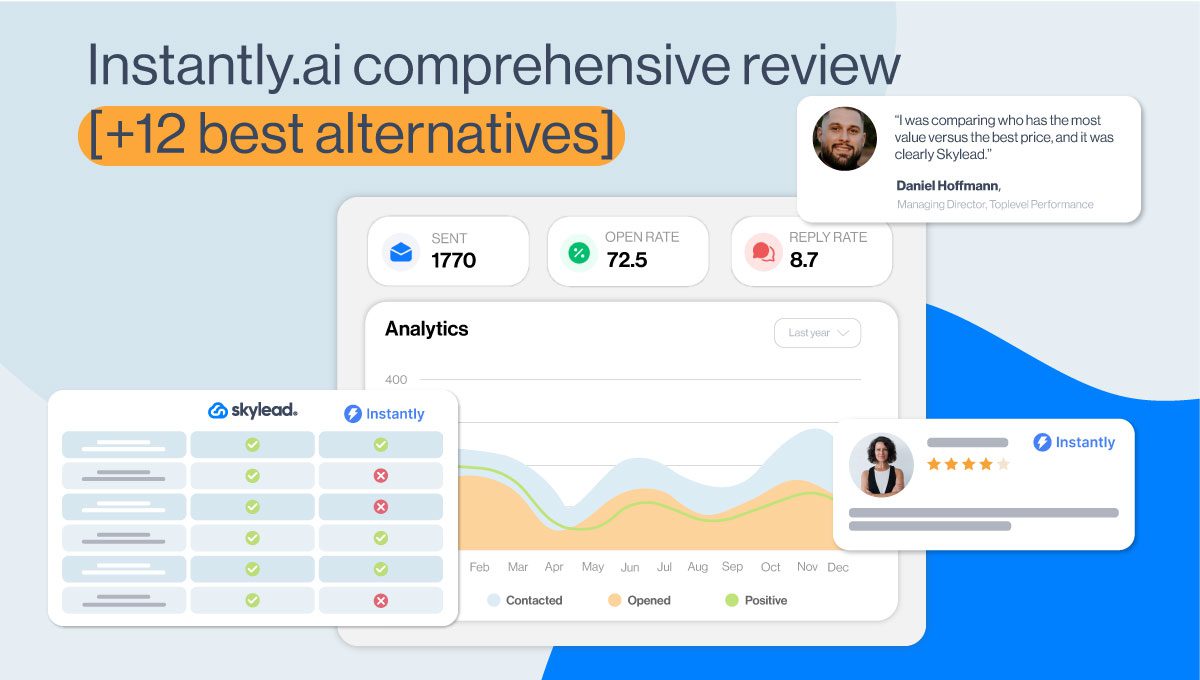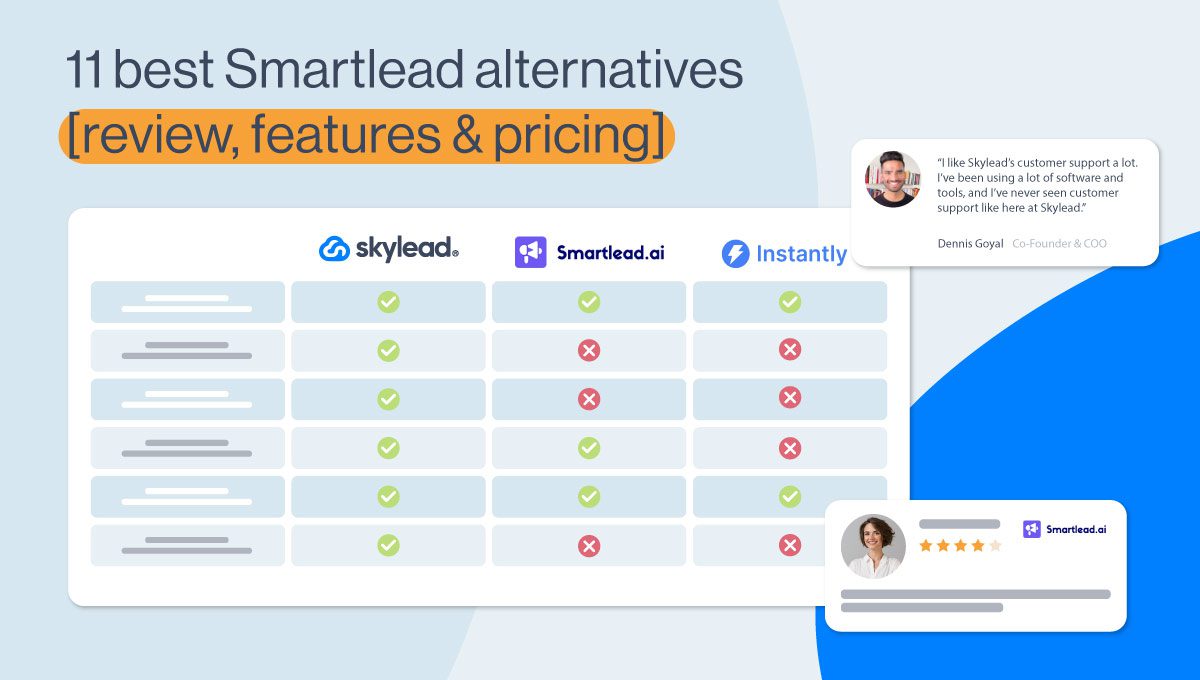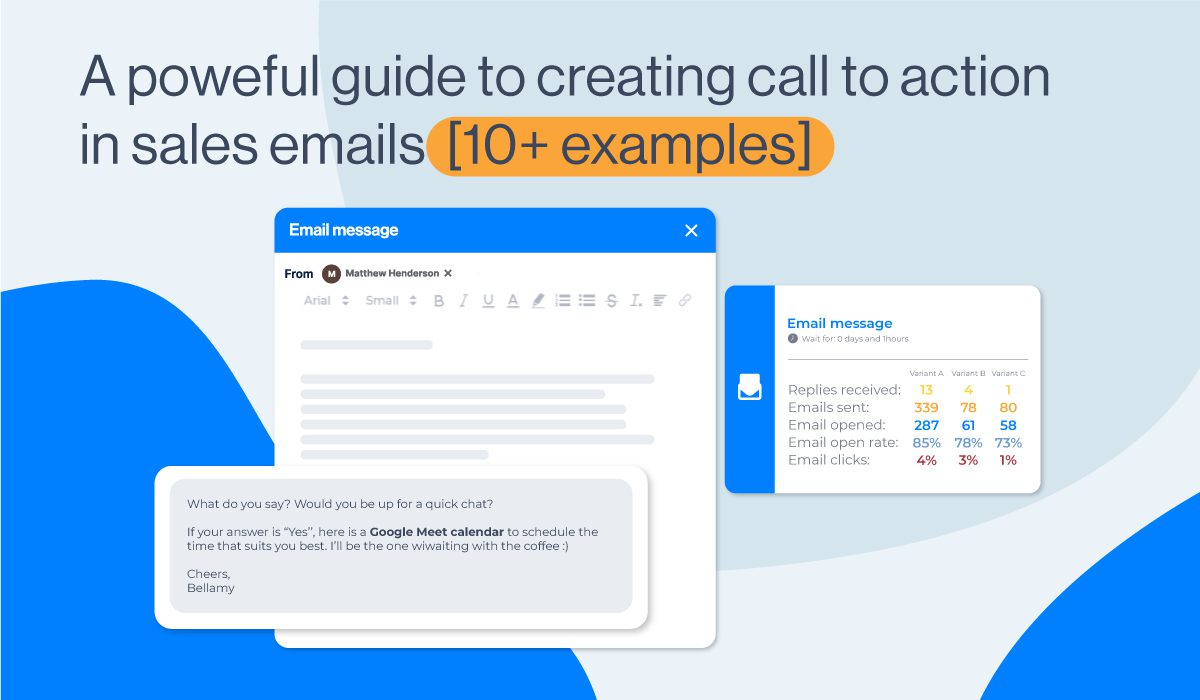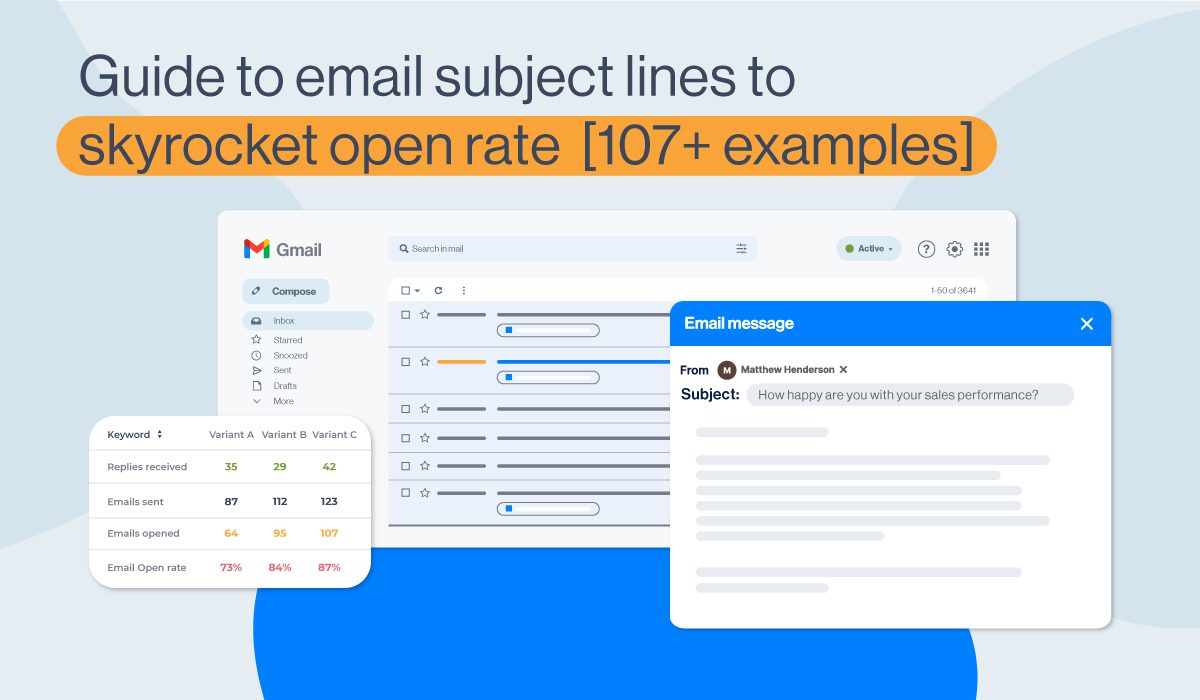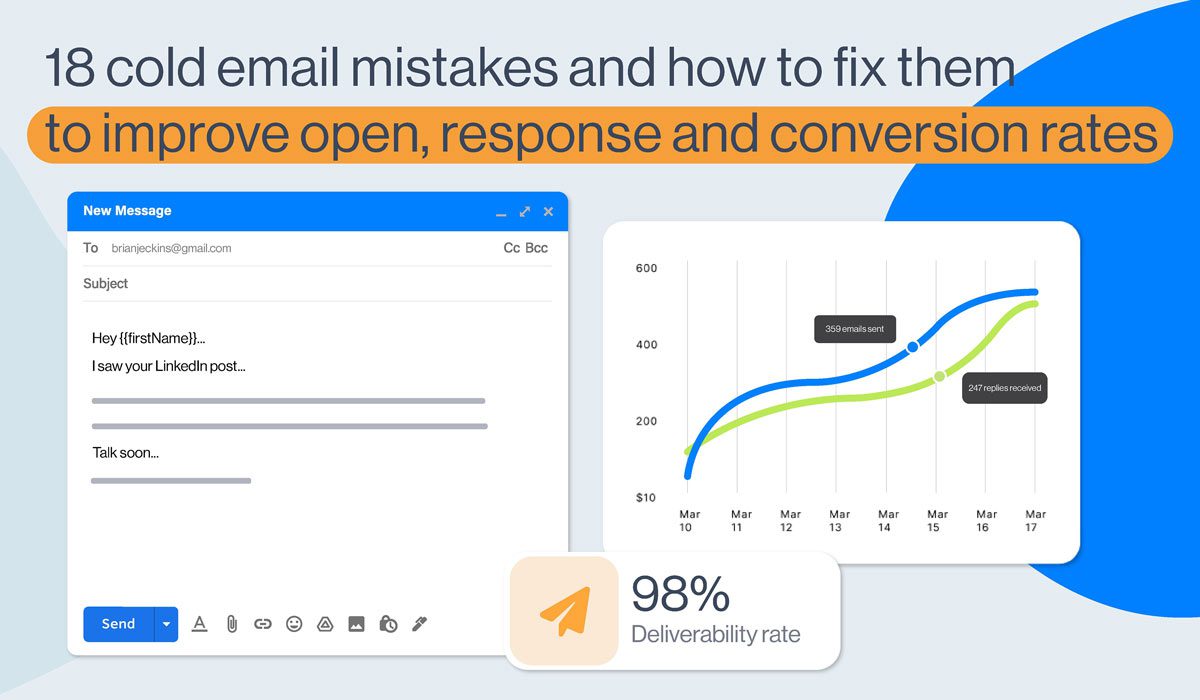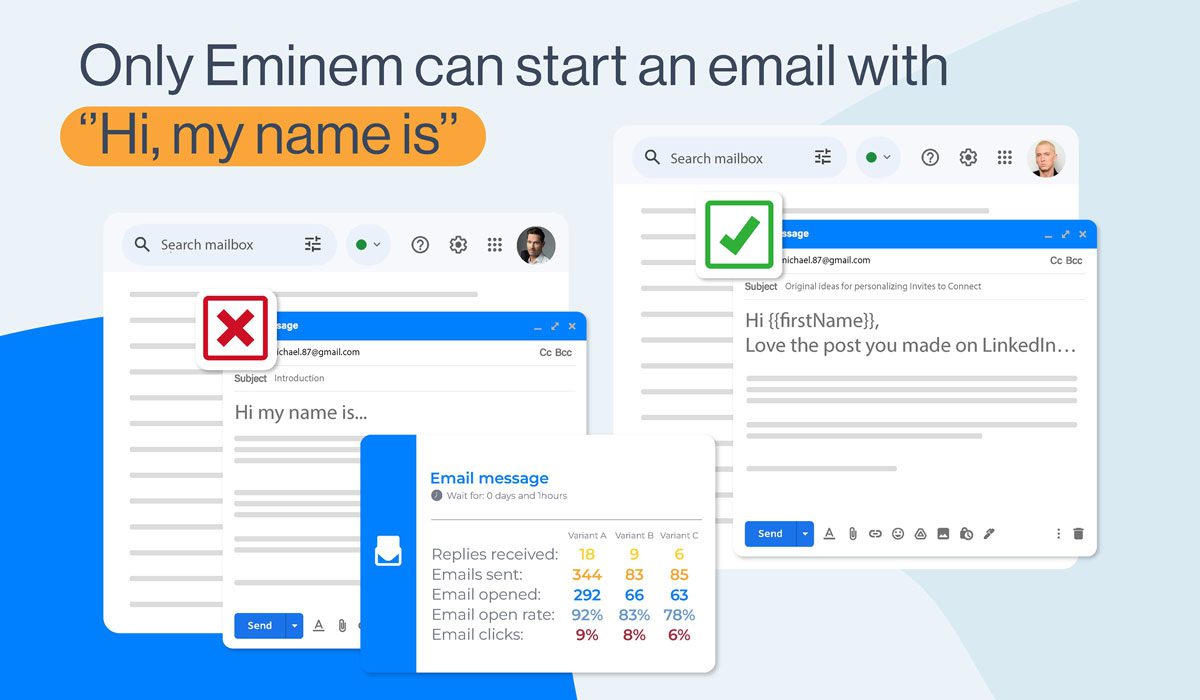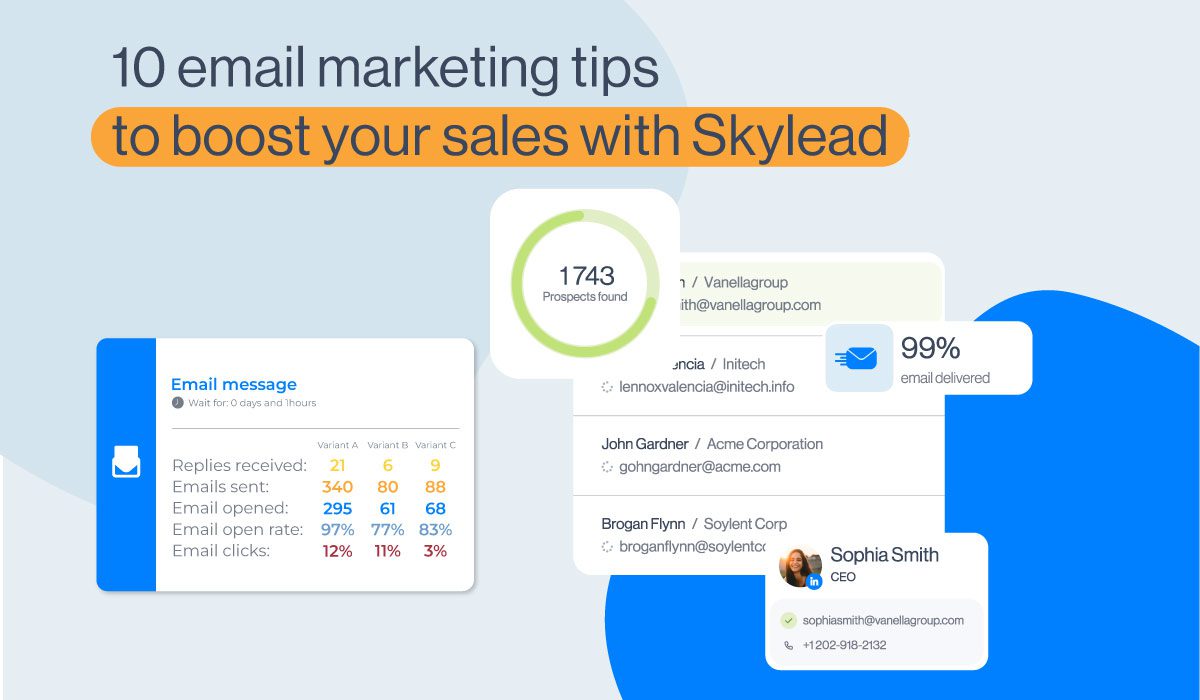What is outbound email marketing and how to use it? [2024 guide]
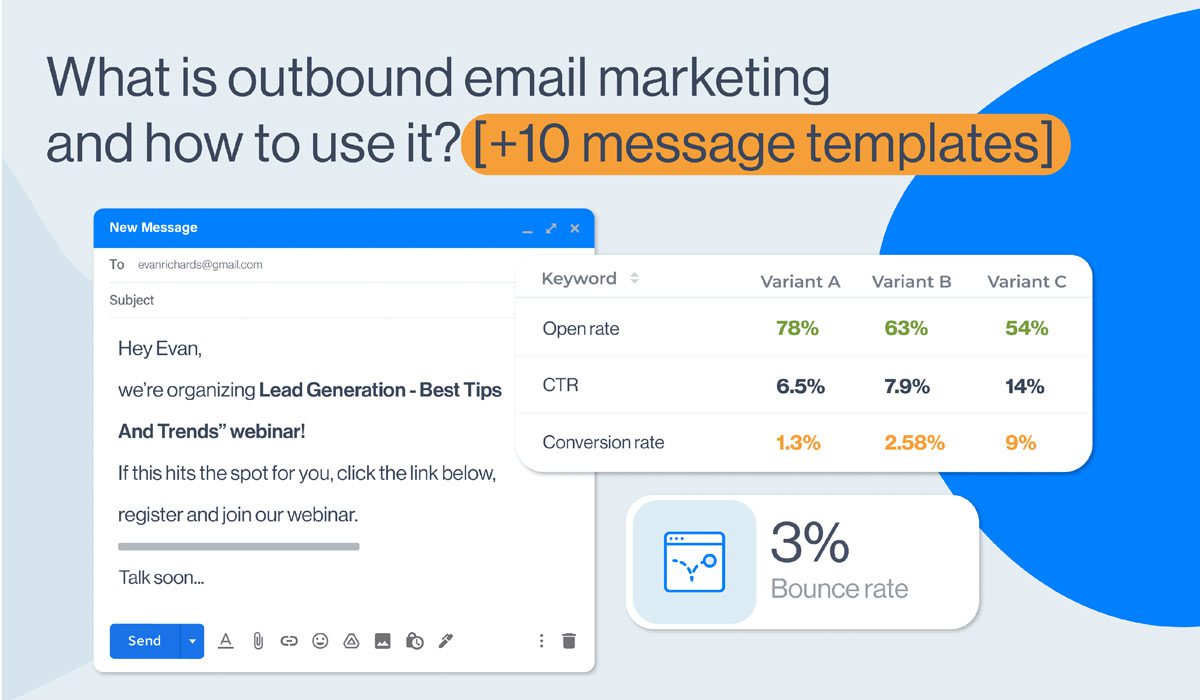
You’ve got a tool or a product to market? Or do you need to share your content and reach a wider audience? If the answer is yes for both questions, say no more. This is our call to action for you to discover outbound marketing and its benefits.
After sending hundreds of thousands of emails to potential customers using Skylead software in the past couple of years, it’s safe to say that we’ve gathered unique insights into best cold outreach practices and emerging sales trends. Not to mention that we’ve managed to skyrocket the number of users from 2,500 to 10,000 in just 9 months! It’s all been written in our sales e-book. Thanks to our software, you can do the same.
So what is it about cold calling and outbound prospecting that seems so promising? In this article, we will share our knowledge and explain what outbound marketing is, its main benefits, and how it is different from inbound email marketing. Finally, you’ll learn from examples and see all the secrets of crafting the perfect outbound email for your marketing efforts.

What is outbound email marketing?
Outbound email marketing is one of the traditional forms of direct email marketing, where you reach out to potential customers by sending unrequested “cold” emails. In fact, it is similar to cold calling, where your potential customers are somewhat or completely unfamiliar with your product or service.
However, the main goal of outbound marketing as a marketing strategy is:
- to build a solid connection with your target audience
- spark interest in exploring your product
- raise brand awareness
The outreach game goes something like this: first, you finish your outbound prospecting, then you craft an outbound email marketing strategy, and finally, send cold emails and follow-ups to your prospects.
You can use cold emails as a powerful weapon to reach out to potential leads. Although these cold emails may be unsolicited in nature, the key to good outbound marketing is to be persistent, patient, and ready to test, adapt, and optimize your approach along the way.
What are the benefits of outbound email marketing?
Some benefits to keep in mind are: reaching a wider audience (more exposure means more potential conversions), fast results (scheduled outreach at the right time means immediate action on your lead’s part), and strategic targeting (targeting a specific audience and their pain points means a higher response rate).
When it comes to building brand awareness, you can always use digital marketing with all of its segments that need to work together, like social media, SEO, and content marketing. These powerful tools can help with getting your service or product out there, but outbound email marketing? This is where the real exposure comes in.
What is the difference between outbound and inbound email marketing?
While it could seem like outbound and inbound email marketing messages are the same, the approach we use in these two types of emails is different. The main difference is that inbound marketing works with leads who already gave you permission to contact them, opted-in, or showed general interest in your company’s products or services.
Inbound email marketing benefits:
- Interested potential customers
- Results over time
- Lead nurturing
- More engagement = more loyal relationships with your target audience
- Cost-effective
With inbound marketing, you wait for your qualified prospects to get hooked on your content. The content is purposefully placed to catch their attention, as it matches with the target audience's pain points and your ICP.
On the other hand, when it comes to qualified prospects for outbound marketing, leads can also match your ideal customer profile (ICP) perfectly. One thing to note: a qualified prospect enters the sales pipeline with outbound prospecting efforts, so it’s safe to say that using both inbound and outbound marketing for lead generation can largely benefit your sales and marketing efforts.
Lastly, both inbound and outbound marketing use lead management, but the process differs, as the way we label the steps as we go along. That why various businesses and B2B email marketing agencies use a CRM like Hubspot to help them with lead management and keeping track of the conversations with prospects.
Understanding the key components of outbound email marketing
Contacts
One of the foundational elements of outbound email marketing is collecting contacts. After outbound prospecting efforts, you should have a narrowed list of emails from your target audience that matches your ICP. Additionally, you can automate lead generation by researching your prospects on LinkedIn and letting Skylead do the work for you with our Email discovery and verification feature.
Accounts
Engaging directly with varied audiences over the years has helped shape our understanding of outbound email best practices. This is why we know that managing and grouping your contacts through accounts is a must for streamlined, well-operating sales efforts. This way, you make sure that you and your colleagues do not reach out to the same contact twice.
Segments
Categorizing your contacts into different segments once they respond can help with tracking the results of your outbound email marketing campaign. Therefore, a helpful feature to use is Skylead’s Smart Inbox which lets you label your prospects by the level of interest, specific data points, next step in the campaign, or practically anything you want.
Lists
Last but not least, email lists are a collection of prospect emails acquired thanks to lead generation techniques. You can use a CRM such as Hubspot or Salesforce to view and organize your prospect list. After acquiring the right contacts, the next step is to send that first email with a strong CTA.
Note that it is never a good idea to purchase email lists unless you want your email to enter the prospect’s spam folder or bounce, which can damage your domain.
Crafting the perfect outbound email campaign
We've learned as much from the few email campaigns that didn't hit the mark as from the many successful campaigns. This is why we know that creating the perfect first email, along with follow-up emails, is crucial. Let’s look at some of your options for a successful outbound email marketing campaign.
Email templates
Contacting people out of the blue has its challenges. If you want to avoid being ignored or your leads hitting unsubscribe, you should focus on proven strategies - implementing email sequence templates for inbound or outbound email marketing. Email templates ensure consistency and branding and can be very efficient when it comes to cold outreach. Building good email sequence templates, testing, and improving them is the best advice we can give you for outbound marketing.
Personalized templates
In the vast sea of received daily emails, you need to allow your prospects to tell the difference between promotional emails and your outreach attempt. This is where personalized emails come in, as they let you send relevant content to potential prospects, increasing the open rate and overall email deliverability and response rate.
For example, Skylead has thoroughly tested text & image personalization in cold emails, and we came to the conclusion that the response rate jumped to 63%. With that in mind, you can use a different, personalized approach for each segment and list of prospects and level up your outbound marketing game, thus skyrocketing your return on investment.
Integrating with other marketing channels like LinkedIn
We’ve teased about it before, but now it’s time for you to consider making your outbound outreach bigger and louder by integrating other marketing channels. Multichannel cold outreach is what amplifies your outreach efforts and gives you an opportunity to reach more people, faster. But how?
We’ve tested and trialed many outreach methods but came to the conclusion that using multichannel outreach means reaching all leads from your list, one way or the other. By incorporating another channel and combining the two, we get a chance to reach people who are not as active on one channel or the other, thus getting more responses.
That is precisely why we’ve created both features in Skylead - a startup and a LinkedIn automation and cold email software that focuses on, you’ve guessed it, multichannel outreach. We’ve helped over 15,000 users with their cold outreach, skyrocketing their numbers and revenue.
You can use our Smart sequence builder to create campaigns from scratch or use some of our proven templates to skyrocket your outreach as we did. Our first-to-market Smart sequence feature combines two outreach methods and scales up conversion rates and return on investment, thus supercharging your outreach efforts.

Best practices for outbound email marketing messages
Crafting compelling subject lines
From our experience, what makes or breaks your outbound sales email is the email subject line and the pre-header text. They can determine whether your prospect opens, deletes, or marks your email as spam. Be sure to know your target audience well, and A/B test your content frequently. How do we know? We’ve tested it out.
We came to the conclusion that the best formula is using personalization. Firstly, this means dropping your lead’s first name or company name into the subject line. Secondly, you can reference their online activity or a mutual connection to grab their attention immediately. Try it out, and you’ll see instant results.
Keeping your email short
After running numerous outbound campaigns and testing shorter and longer content in emails, we’ve figured out a behavioral pattern: there’s a series of split-second decisions your prospects make when they see an email. First, if the subject line catches their eye, they decide to open the email.
The second decision happens right after, when your prospect is looking at the email body. We came to an understanding that if the email seems too long, the prospect might make the decision not to read the email, regardless of content relevance. This is why we believe it is crucial to keep your content short and concise.
Personalized intro
If you’re reaching out to someone, outbound style, at least make the effort to personalize the intro. This includes adding some personal information about the prospect besides their name and showing them that you’ve done your research well. Our sales team has done it by using our tool, Skylead. The response rate for a hyper-personalized sequence we’ve tested has increased from the industry standard of 8.5% to 35%. Not bad for just a little extra effort, right?
Clear purpose
In your email copy, make sure to state your purpose clearly! Your prospect needs to understand your intentions right away. Of course, being clear doesn’t mean being blatant, so make sure to find a subtle balance.
CTA
They say a good call to action should be the last thing your prospect reads and the first thing they do. Therefore, make sure to craft your CTA in an unimposing yet clear manner.
Timing and frequency considerations
When people said that timing is everything, they had outbound email marketing in mind. Hence, sending an email at the right time can affect your conversion rates. One more important thing to note is the frequency of sending each follow-up email, as it can shield you from ending up in your lead’s spam folder. Research suggests that a single follow-up can increase the reply rate from 9%-13%. Also, make sure to wait at least 3-5 business days between follow-ups.
Ensuring mobile-friendliness
If we know that the majority of email views come from mobile devices (41%), then it’s safe to say that your email should be mobile-friendly so your mobile open rates are high. To optimize your cold email, keep the subject line (35 characters) and pre-header text (85 characters) within the character limit You should also left-align your email copy and opt for a single-column layout. Most email campaigns aren’t optimized for mobile, so make sure to use this information to your advantage!
Bonus tip: Always test your email on a mobile device before sending it out to ensure that the formatting and visuals appear as intended.
Email example:

Executing your outbound email strategy
Whether you’re sending a welcome email, newsletter email, or promotional email, the execution is similar in each campaign. However, implementing an outbound email strategy is a bit different, given the cold nature of the campaign. What differs is the tone of voice and your overall approach. Nonetheless, most strategy outlines look like this:
- Choose a relevant email list (with your target audience in mind)
- Design your signature (logo, design, etc.)
- Personalize your email (subject line, relevant content, tone of voice)
- Create follow-ups (in case the lead is not responding immediately)
This is considered the foundation of any email marketing strategy. But, as we’ve said, that’s not all there is to it. When you’re looking to implement an outbound email strategy, there are things to keep in mind before and after the campaign starts. Here are some helpful tips to consider before launching your campaign:
- Send emails from a real person (for higher open and response rates)
- Follow email or spam regulations and the GDPR (to avoid spam filters or your email accounts getting banned)
- Hyper-personalize your outreach (by using the Image & GIF personalization feature for a higher email response rate)
After launching your cold email campaign, it is important to note that you need to continue working on improving and refining it. This is where A/B testing comes into play. In fact, QA, A/B testing, and spam testing lead to a 28% higher return on investment, so be sure to use them continuously as the campaign goes on.
Skylead gives you the option to A/B test your content copy and create up to 5 text variants. Managing a good outbound campaign means you need to optimize and adapt on the go for optimal results. You don’t want to end up in your prospects’ spam folders, do you?
Using automation in outbound email marketing
There’s a lot of manual work involved in executing a successful outbound marketing campaign. But what if you use marketing automation instead? Using outbound email automation software can cut hours of manual work, which you can use to focus on other parts of your outbound campaign.
Here are some other advantages of marketing automation:
- Faster outreach (for faster results)
- Automated outbound prospecting (with the email discovery feature)
- Better tracking (analytics, content success, and lead behavior)
Moreover, good automated outreach tools have all the features that support a successful outbound email campaign, such as:
- A/B testing content copy
- Email discovery
- Integrated inbox
- Hyper-personalization
- Using other communication channels (apart from email)
Skylead is all about automation and, coincidentally, one of those tools. 😉
Jokes aside, Skylead is a LinkedIn automation and cold email software and can help significantly with automating your outbound campaigns. With our tool, you can utilize multichannel outreach and scale up your outbound outreach efforts.
Measuring the success of your outbound emails
As we’ve learned from sending thousands of emails ourselves, once your campaign is live, that’s not where your hard work stops. In fact, this is where the real work begins. We cannot stress this enough! Tracking and interpreting email metrics is the most important part after the outbound campaign launch.
Key metrics
- Open rates - This is one of the most important metrics for email marketing. It shows you the average number of open emails from your campaign. If you want to analyze the effectiveness of subject lines, pre-header text, and sender names, you should consider your open rate numbers.
- Click-through rate - This metric measures the number of times your prospects clicked on any links or CTAs that were inside your email. Click-through rate is important for determining email engagement.
- Conversion rate - This metric indicates the number of people that converted (did the end-goal action) from your specific email or campaign in general. It determines the overall success of your campaign.
- Bounce rate - The bounce rate shows you the number of contacts that “bounced” or didn’t receive your email. This usually happens when the email address is inactive, fake, or outdated. To avoid having a high bounce rate, and staying out of trouble with your email service provider, make sure that your email addresses are legit, or simply use tools that support Email discovery and verification. You’ll get verified emails only and thus significantly lower your bounce rate.
- Spam complaints - This metric shows you how many times your email was marked as spam. Spam complaints could happen due to irrelevant content, spammy-looking subject lines, or unsolicited emails.
- Unsubscribes - This metric is meant to show you the number of people who unsubscribed from your email list. Having a high unsubscribe rate could mean one of two things: the content isn’t relevant for your audience, or your emails aren’t being sent to the right prospects.
- Mobile open rates - The number of emails opened on mobile devices.
Other metrics
Other metrics to track include deliverability rate, best-performing links, revenue per email, email sharing rate, etc. Despite the numerous things that you can track, from our experience, too much data leads to indecision. Therefore, make sure to follow the metrics that align with your campaign end goals for easier decision-making.
Finally, you should always use your analytics to adapt and constantly refine your outbound email marketing campaigns. Numbers are your allies here and can significantly help with overall campaign success.
Examples of outbound marketing
To give you some examples of outbound email outreach, we’re going to show you how it’s done with the help of Skylead’s Smart sequence builder. This is how you build a sequence in the Skylead app:
- Go to your Skylead campaigns dashboard and click on “Create new campaign”. 📢
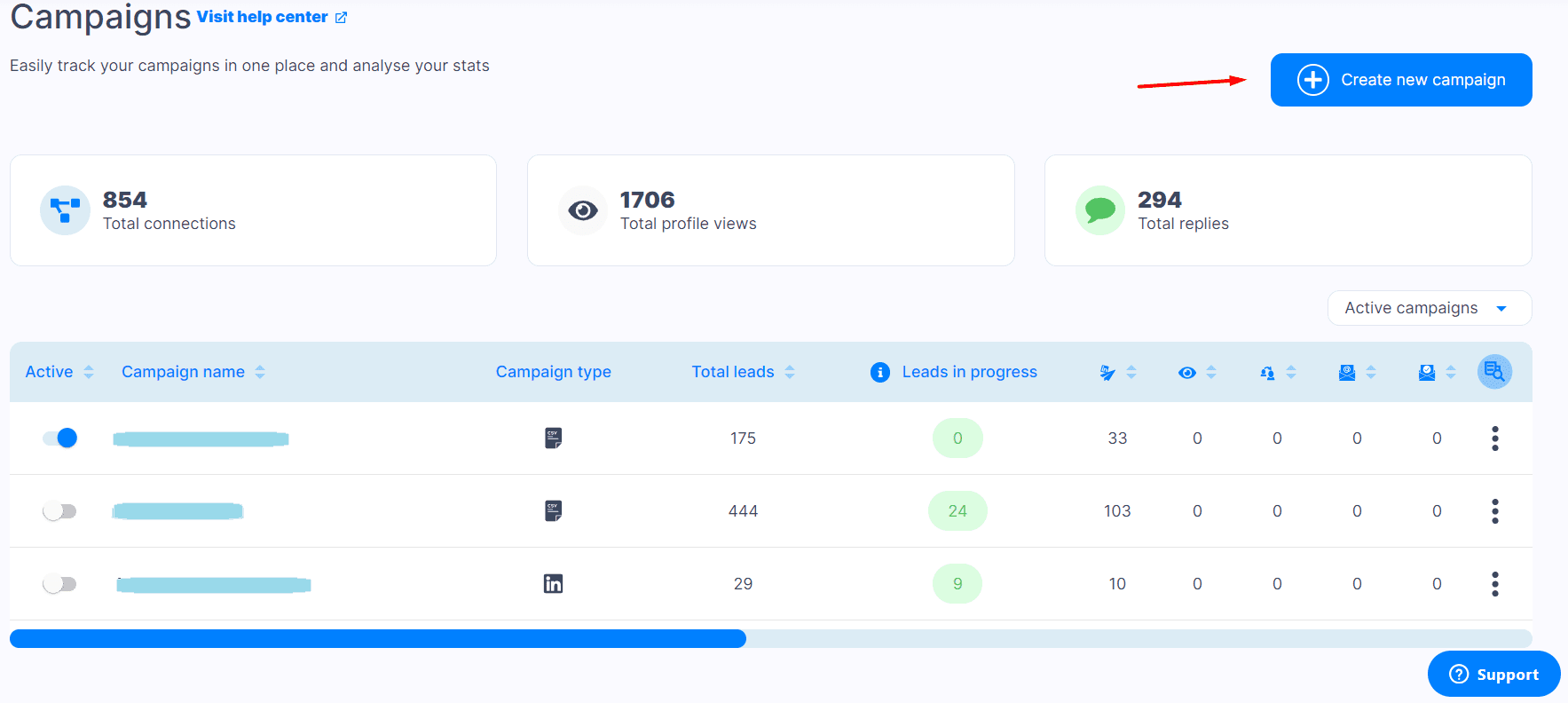
2. Name your campaign.
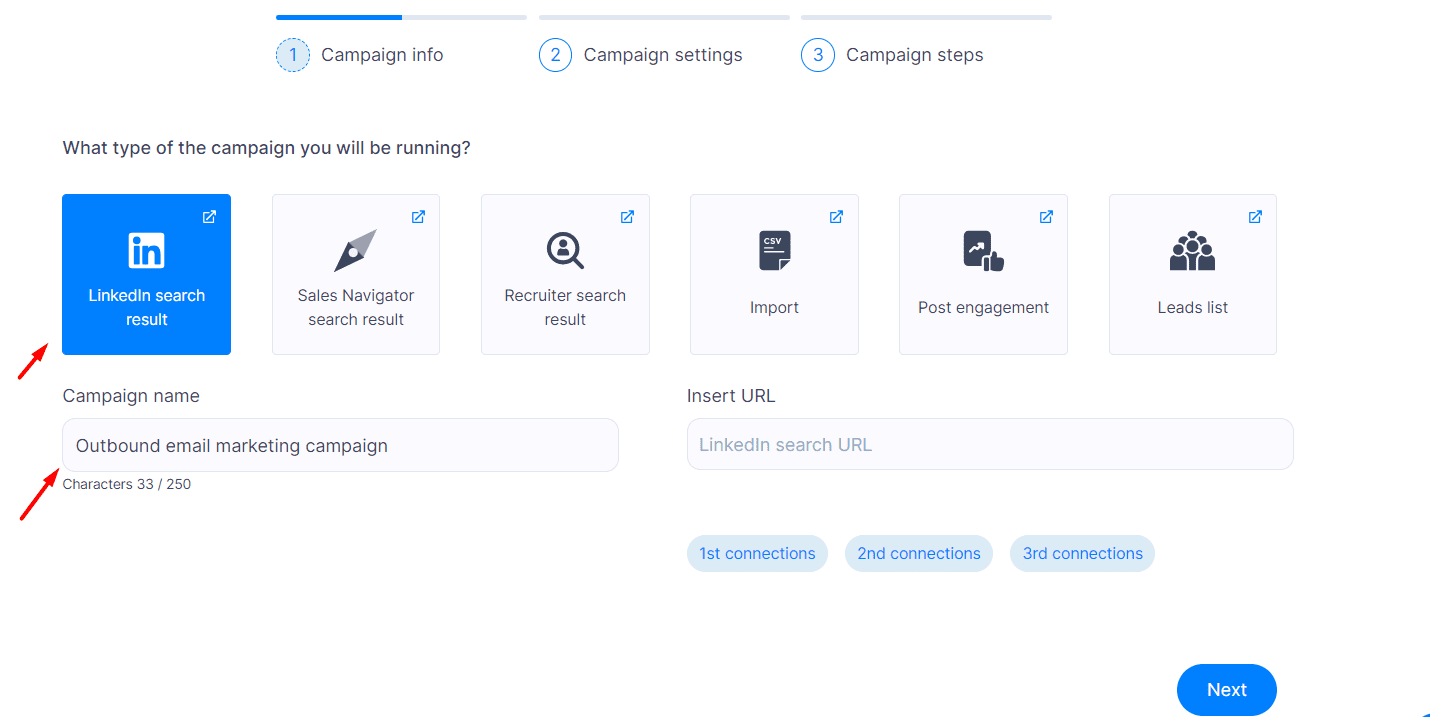
3. Paste a LinkedIn search URL, or add some other source out of six possible lead sources.
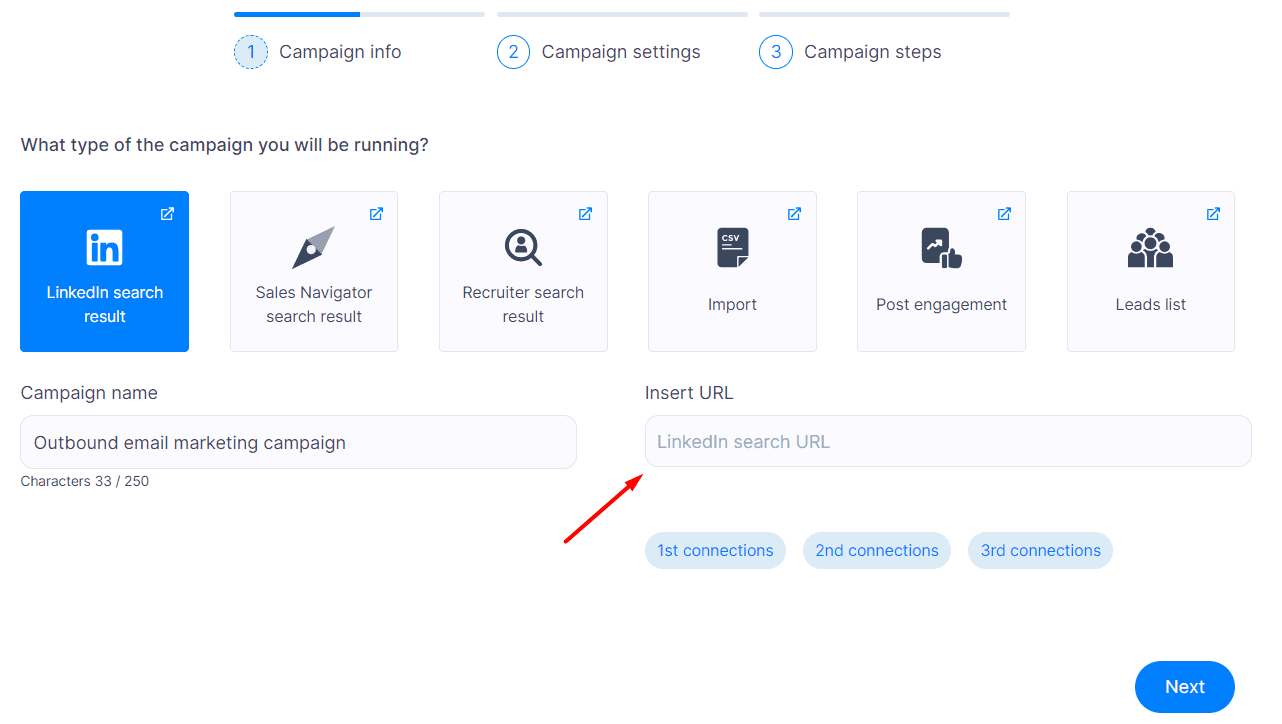
4. Adjust your campaign settings and click on “Create campaign.”
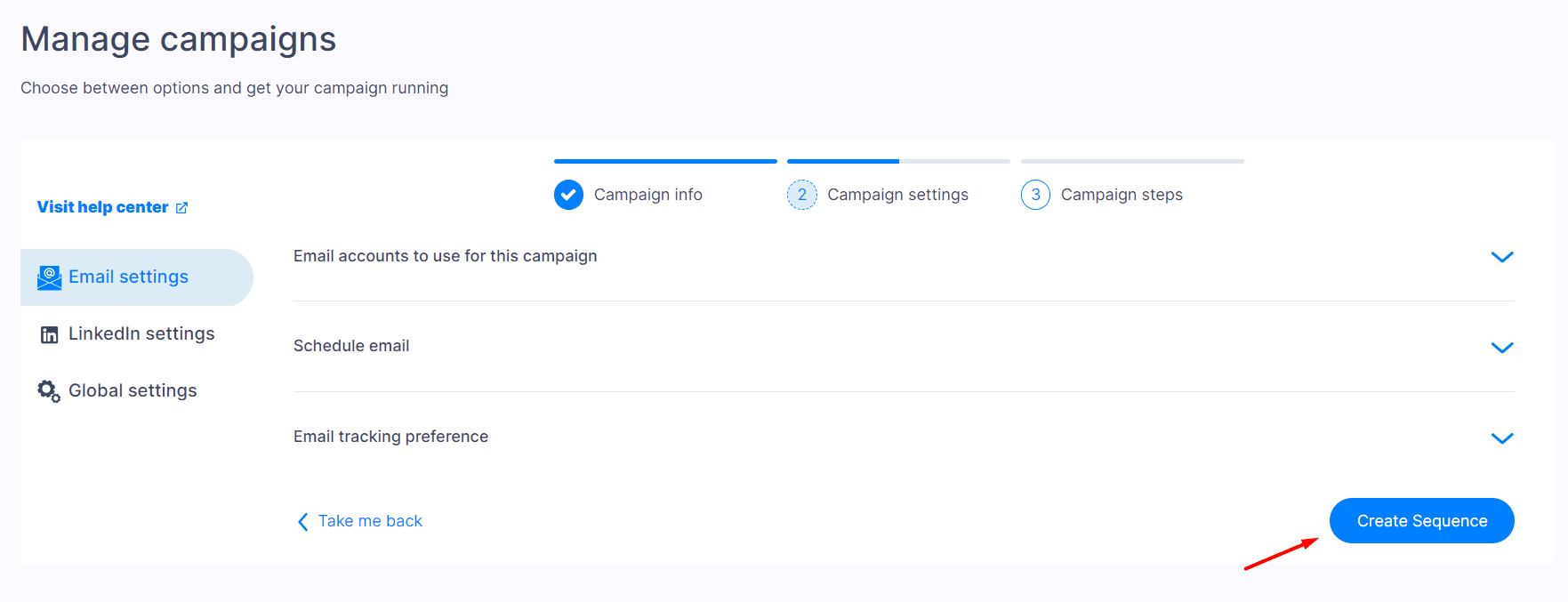
5. After you click on “Create campaign,” a popup will appear. You can choose one of two options. Click on the “From scratch” option.
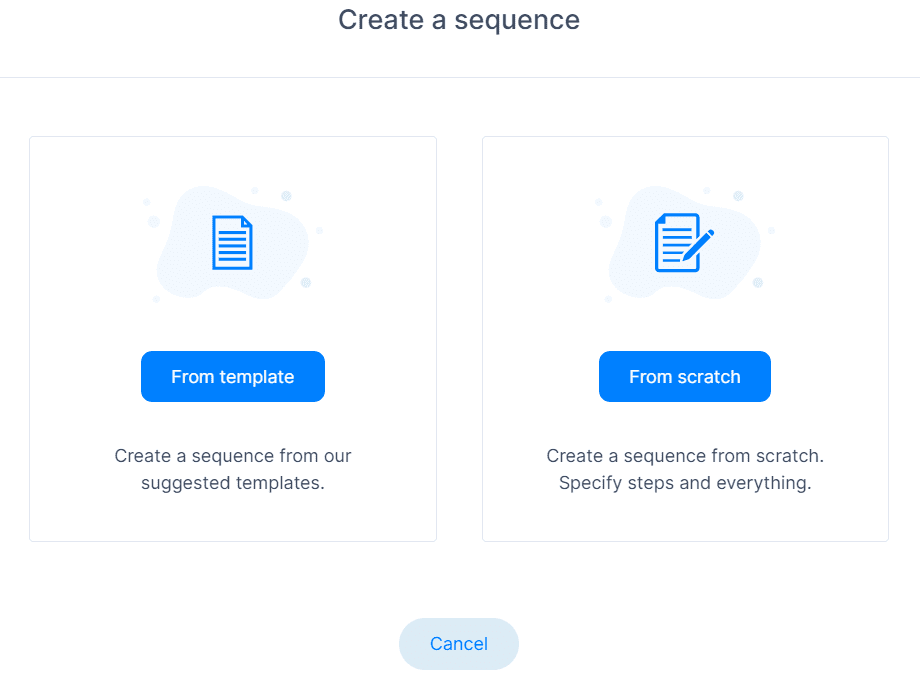
6. The next step is adding your campaign elements, actions and conditions to form your outbound campaign.
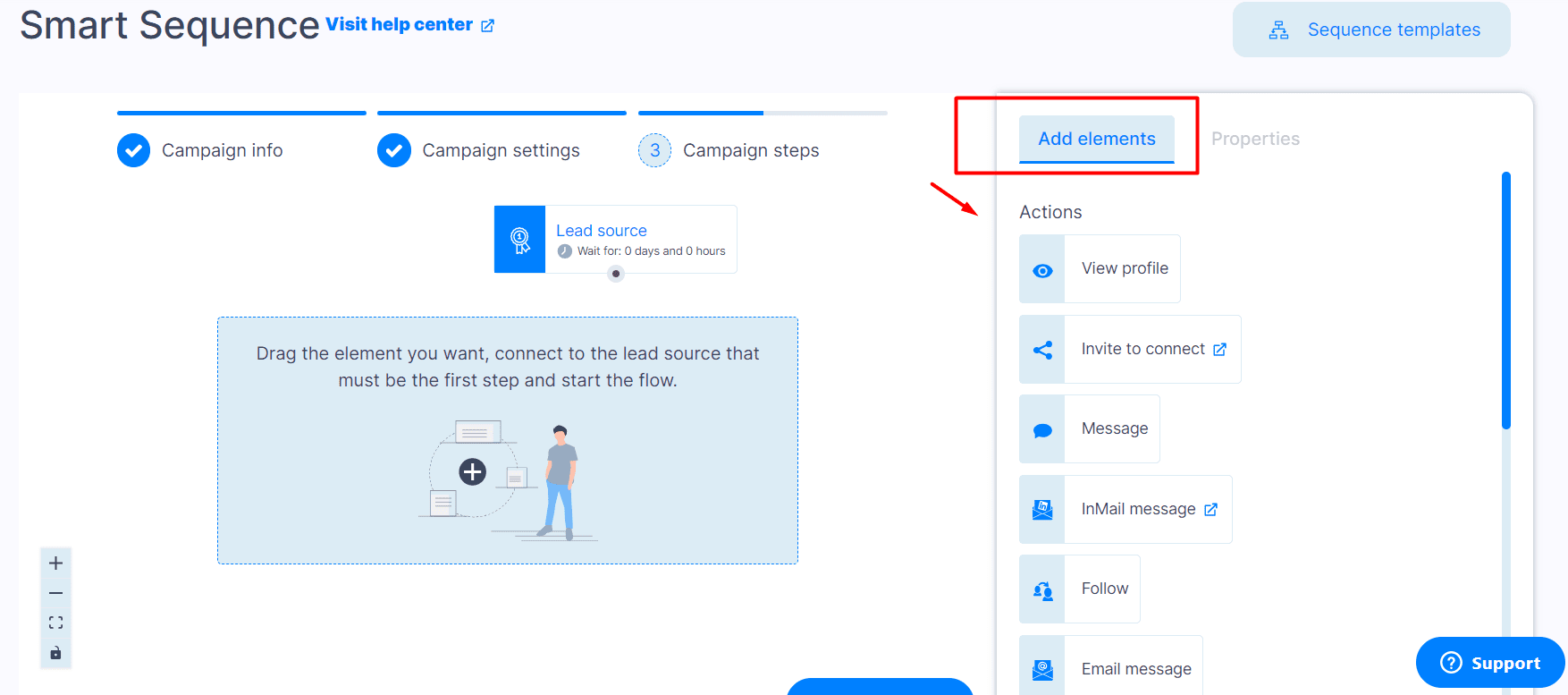
We’ve tested and perfected the following sequence as an example of a simple outbound outreach campaign. We believe that outbound outreach campaigns are far more effective when you use the multichannel approach. Therefore, this sequence combines email and LinkedIn outreach, with added email, LinkedIn message, and InMail examples for two different outbound campaign scenarios:
Open rate: 63%
Scenario #1: Content distribution or event promotion
If you want to get more eyes on your content or more sign-ups for events, these templates will be a perfect way to do so.
First email:
Subject: {{solutionToPainPoint}}: Exclusive {{typeOfContent/Event}} Inside
Hi {{firstName}},
Facing {{painPoint}} challenges? We've got a solution.
We’ve created a {{typeOfContent/Event}} to specifically address these issues.
Check out our {{content/EventName}} and get hands-on experience on how to achieve {{results}}.
Cheers,
{{yourName}}
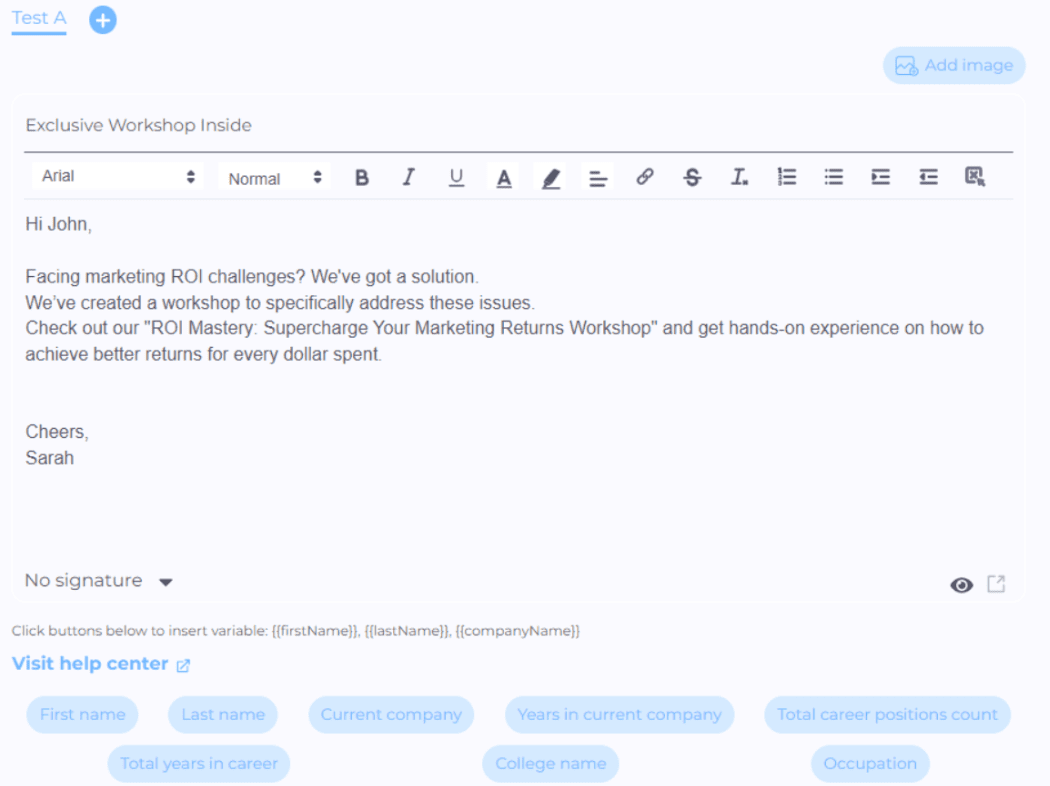
Follow-up email:
Subject: Missed Our {{typeOfContent/Event}} on {{painPoint}}?
Hi {{firstName}},
Just checking in about our exclusive {{typeOfContent/Event}}. It's tailored to help you achieve {{results}} by addressing {{painPoint}}.
Does this {{typeOfContent}} resonate with you? We would love to hear your thoughts.
Best,
{{yourName}}
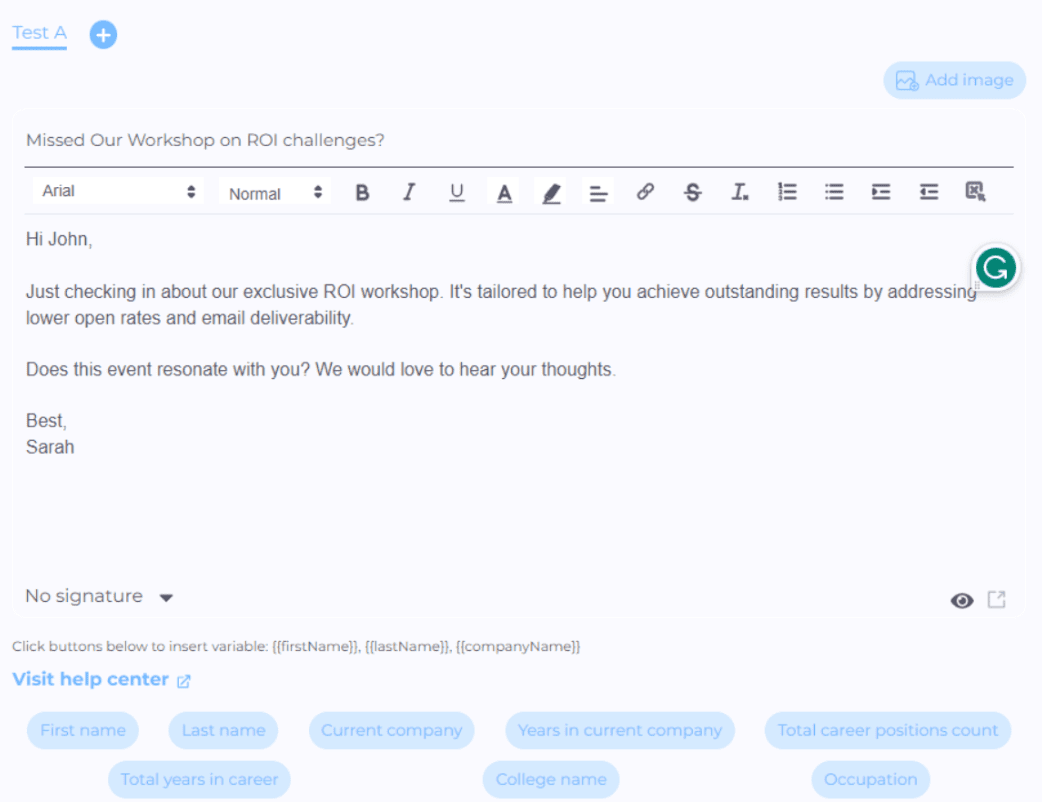
LinkedIn invite to connect message:
Hi {{firstName}},
Your work in {{specificField}} caught my eye. We’ve created something that will turn the tables on {{painPoint}}. I think you'd find it very useful and inspiring, so I wanted to reach out and connect on it.
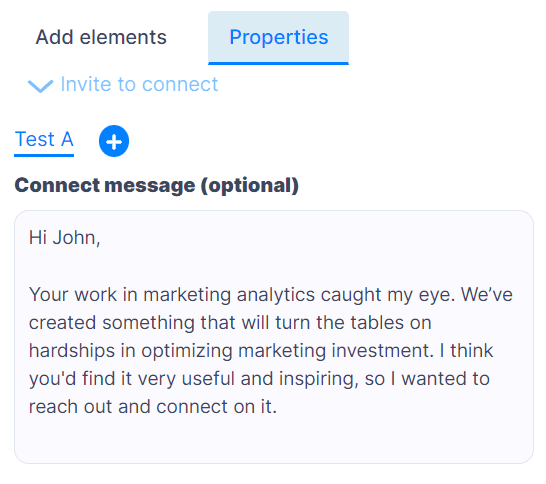
LinkedIn message:
Hi {{firstName}},
Thanks for accepting my invite. Here’s a link to {{content/EventName}}, which focuses on {{painPoint}}. I really think you, as a {{occupation}}, will benefit from it.
Please let me know if this hits the spot.
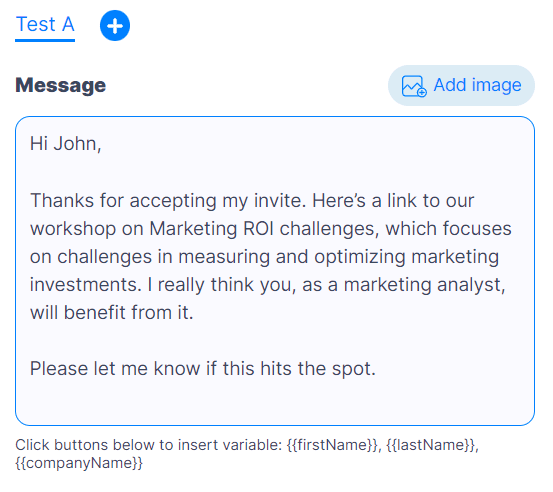
InMail message:
Subject: Let's Tackle {{pain point}} Together!
Hi {{Recipient Name}},
Noticed we missed connecting earlier, but your expertise in {{specific field/interest}} truly stands out. I wanted to reach out to share {{content/event name}}, aimed at {{pain point}}. Considering your background, I think it's perfect for you.
Does this hit the spot for you, as a {{occupation}}? I would really love to hear your thoughts on it.
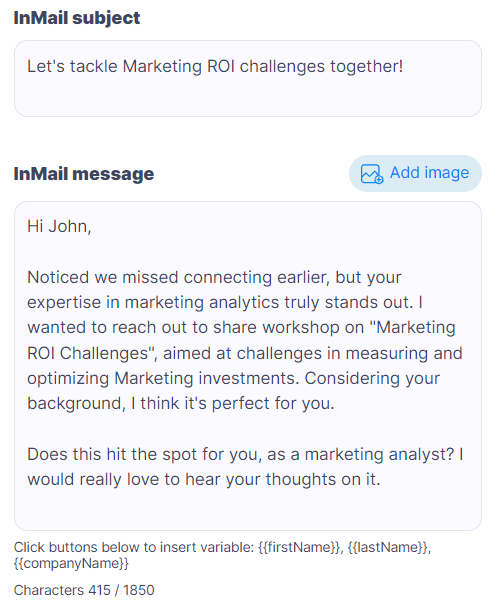
Scenario #2: Product promotion
If you’re a lead generation manager, these templates might come in handy.
First email:
Subject: Get {{results}} With This Tailored Solution
Hi {{firstName}},
I've been following your posts on LinkedIn because they talk about {{specificField/Interest}}, which I always love to see myself. Without taking too much of your time, I would like to showcase a product, {{productName}}, that reminded me of some of the challenges and topics you've discussed. It offers a unique approach to {{painPoint}}
I thought it might resonate with you. Mind if we jump on a call and talk more about it?
Warmly,
{{yourName}}
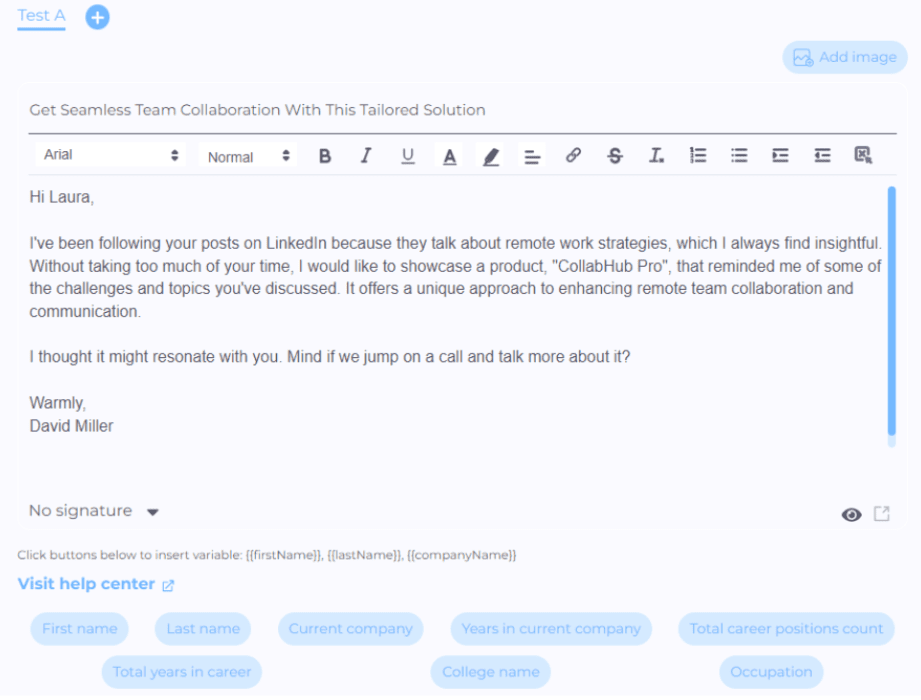
Follow-up email:
Subject: {{productName}}: A Fit for Your {{occupation}} Workflow?
Hi {{firstName}},
Revisiting our chat about {{productName}} – its features seem to align well with your work in {{specificField/Interest}}. To be more specific, with {{productName}} you can:
- {{benefit}}
- {{benefit}}
- {{benefit}}
How about it? Would you like to jump on a call, so I can get to know your precise workflow and create a tailor-made strategy that you can use to reach {{results}}.
Best,
{{yourName}}
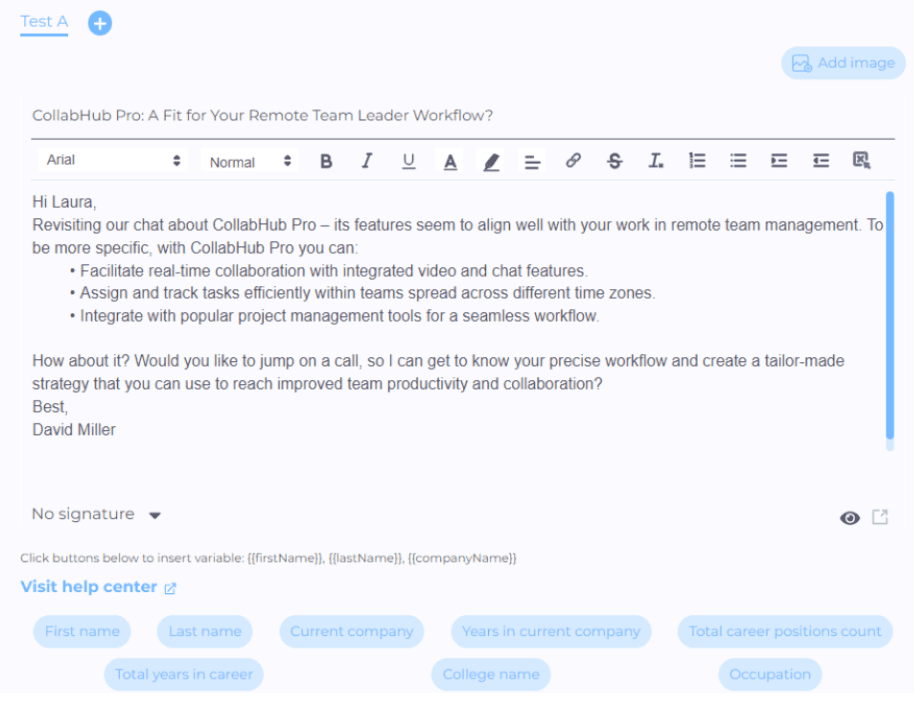
LinkedIn invite to connect message:
Hi {{firstName}},
I was blown away by your posts on {{topic}}! As I also share your passion for {{topic}}, I wanted to connect and exchange our experiences.
Perhaps there is a potential for a collab.
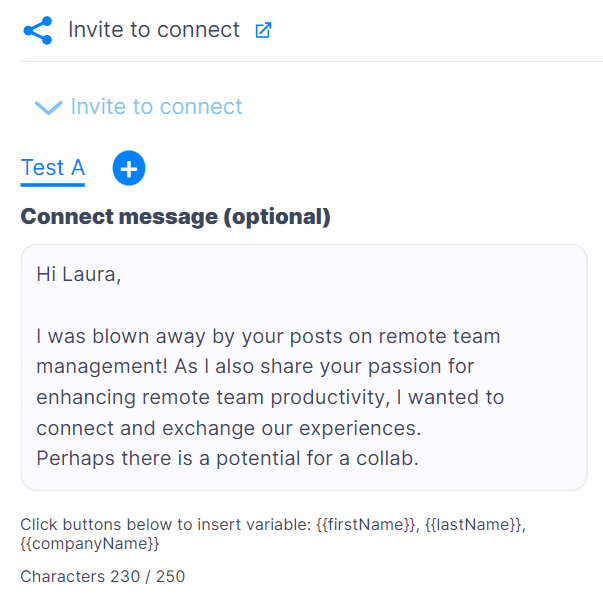
LinkedIn message:
Hi {{firstName}},
Thanks for linking up! Your forward-thinking approach with {{topic}} sparked a thought - what would you say if I told you that {{productName}} can help with {{painPoint}} and deliver results?
Would you be up for a quick chat about it?
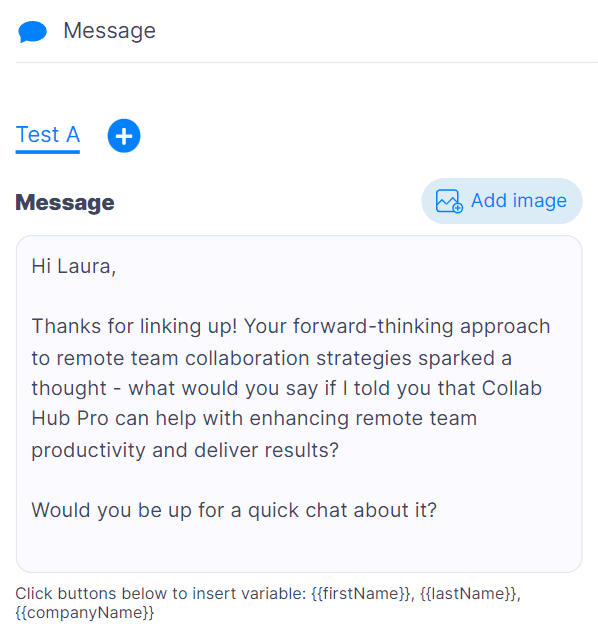
InMail message:
Subject: Let’s Speed Up Your Workflow With {{productName}}
Hi {{firstName}},
I noticed we hadn’t had a chance to connect earlier. Your amazing post on {{topic}} really stands out from the crowd. It got me thinking about {{productName}}, which seems tailor-made for {{painPoint}} that you’ve highlighted in your post. With {{productName}}, you can:
- {{benefit}}
- {{benefit}}
- {{benefit}}
I would really love to chat about it since I believe you can greatly benefit from it.
Let me know when you’re available so we can discuss the potential.
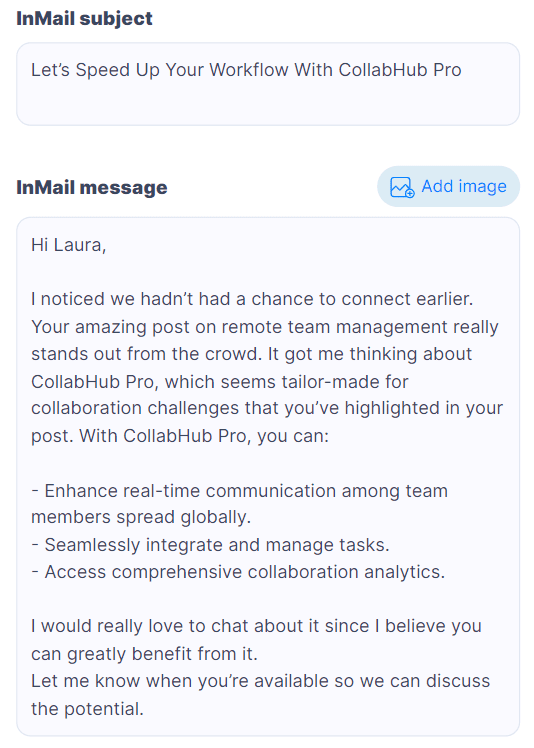
Frequently asked questions
Is cold email outbound marketing?
Yes. Sending cold emails is the foundation of outbound marketing. When done right, it could help with brand awareness or bring traffic to your website. It can even act as a lead magnet, thus being one of the most powerful channels of outbound marketing.
How can one effectively measure and optimize the performance of outbound email campaigns to improve future strategies?
To effectively measure and optimize outbound email campaigns, focus on metrics like open rates, click-through rates, and conversion rates. Utilize A/B testing for subject lines, content, and send times to refine your approach based on data-driven insights.
Are there specific examples of how outbound email marketing has significantly impacted business growth or lead conversion rates?
Outbound email marketing can significantly impact business growth by nurturing leads into customers and enhancing brand awareness. Specific case studies highlight increased lead conversion rates and ROI when personalized, targeted email strategies are employed.
What are the most common challenges businesses face when starting with outbound email marketing, and how can they address these challenges effectively?
Common challenges in outbound email marketing include ensuring high deliverability, maintaining GDPR compliance, and crafting engaging content. Addressing these challenges involves using reliable email marketing tools, staying updated on email regulations, and continuously testing and adapting email content strategies.
What are 3 advantages of outbound marketing?
With outbound marketing, you can reach a wider audience but also use strategic targeting to narrow down prospects, find a niche, and enhance your results. Finally, you can get faster outreach results if you contact your prospects at the right time and with the right call to action.
What are the advantages and disadvantages of outbound marketing?
While you can reach more prospects with emails and target your niche well, there are some disadvantages to outbound marketing. Cold outreach could damage your reputation: people tend not to trust emails from unknown senders. Additionally, outbound marketing costs more, depending on the outreach size and the tool you use.
How effective is outbound marketing?
Very effective. If we know that 99% of email users check their inboxes every day, we know that your prospects will surely see your email. It’s up to you to make the content stand out and underline the importance of your CTA, turning a cold into a warm lead.
Is it OK to cold email companies?
No. However, if companies comply with regulations, sending cold emails is legal. Nonetheless, if they do not opt in, you may risk damaging your company’s reputation by sending unsolicited emails. Ultimately, this practice might lead to recipients marking your emails as spam or simply unsubscribing from all future communication.
Conclusion
The immense potential of outbound email marketing is what kept you going through this article to this very point. If your goal is to reach more leads faster, grow your audience, and build brand awareness, then outbound email marketing is your best tactic.
From years of experimenting and testing it out ourselves, we’ve managed to grow our own company and establish Skylead as one of the leading automation tools out there. If we could do it with our own tool, imagine what you can do with it.
